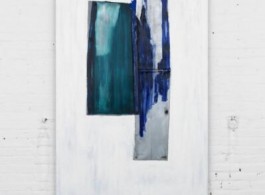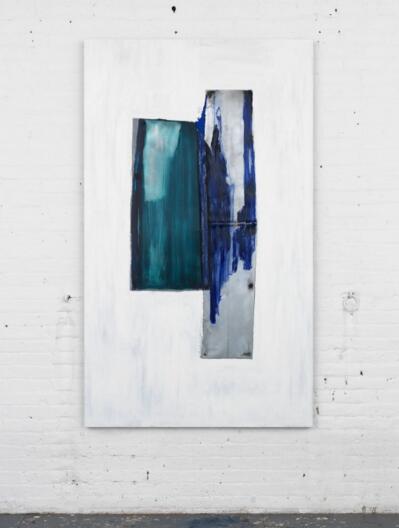Almine Rech Gallery New York is pleased to announce an exhibition of new paintings by Erik Lindman. His first solo exhibition in the city where he lives and works, the show will feature a group of large-scale vertical paintings as well as several smaller works, all of which exemplify his open-ended curiosity about how painting functions at this moment in time. Though his work is notable for its subtlety and its exploration of painting’s constituent parts (including its material supports, pigments, and mediums), Lindman also poses broad questions about why paintings get made and why viewers return to look at them again and again, simultaneously focusing attention on their cultural ramifications and the plain facts of their existence.
The majority of the works on view feature a central, often monumental form isolated on a monochromatic field. If this figure-ground relationship is a constant, the means by which Lindman establishes it differ radically from one painting to the next. In some cases he scavenges materials like luan or stainless steel from his urban surroundings, affixes them seamlessly to panels, and then applies paint to them. In others he proceeds in a more traditional manner, finding forms through the act of painting and inscribing shapes on linen grounds. The preparation and inherent physical qualities of these various surfaces, and the way paint moves across them, become important factors in the evolution of each composition.
Rather than treat the painting surface as a metaphysically pure, idealized concept, Lindman constantly constructs it anew, calling attention to the fact that surface is not a singular phenomenon but always a coming together of materials (including paint itself) that are made to adhere to one another. He has also recently begun to experiment with grinding his own pigments, creating paints that are less uniform in their consistency than their industrially produced counterparts. Such operations introduce a measure of unpredictability that finds expression in the dynamic and thoughtful mood that defines the finished works, which combine the everyday intimacy of collage with the contemplative gravity of minimalist sculpture.
However, Lindman also recognizes that paintings differ from other kinds of surfaces, and retain specific cultural meaning as perceptually active places where viewers are free to engage visual phenomena on aesthetic terms––an engagement that involves grappling with the basic mystery of what makes something ‘aesthetic’ in the first place. The found materials that sometimes make their way into Lindman’s compositions are therefore carefully integrated so that pre-existing narratives about their prior lives out in the world do not prevent them from being read as two-dimensional elements in a painterly syntax. Like the shapes that emerge from his drawing practice and find their ways into his paintings, these materials are no more––and no less––than examples of the ways in which the artist interacts with his environment, translating his experience of local conditions into forms that engender independent experiences for viewers in other places and at other times.
For Lindman, there is therefore no hard distinction between what is found and what is invented. This also applies to the histories of modernism and non-objective painting that inform his work without wholly accounting for its power. Though abstraction has been put to a wide variety of uses in different social and aesthetic contexts, serving as the engine for everything from radical political art to mannerist decoration, it remains possible to consider it as its own category with its own rules, however difficult these might be to define. Lindman orients his work precisely towards this shadowy but intimately familiar place, seeking to channel the animating spirit of a cultural force that can be visceral or cerebral, accessible or rarefied, depending on how––and by whom––it is used. For this reason his paintings are personal documents that directly acknowledge the time and place in which they are made. And while his titles occasionally serve as prompts, pointing toward the memories, observations, or ideas underpinning his imagery, Lindman resists assuming a wholly autobiographical stance. His presence instead serves as a conduit through which each individual viewer is invited to participate in the shared activity of remaking painting, here and now, out of the things that exist around and within us.
Erik Lindman (b. 1985, New York) received his B.A. from Columbia University in 2007. Recent solo exhibitions include ‘Metal Paintings’, Almine Rech Gallery, London (2016); ‘Open Hands’, Almine Rech Gallery, Brussels (2014); ‘Do not touch doubtful things’, ribordy contemporary, Geneva (2013); and ‘Human Personality’, Almine Rech Gallery, Paris (2012). He has been featured in group exhibitions throughout Europe and the U.S., including Expanding Frontiers: Propos d’Europe 15, curated by Rolf Hoff, Foundation Hippocrène, Paris (2016); The Painter of Modern Life, Curated by Bob Nickas, Anton Kern Gallery, New York (2015); The Stand In (or A Glass of Milk), Curated by Alexandra Gaty, Public Fiction (The Museum of), Los Angeles (2013); Pour une grammaire du hasard, Curated by Corrinne Charpentier, Fri Art – Centre d’art de Fribourg / Kunsthalle Freiburg, Switzerland (2012); and Golden Age: Reference Work, Museum of Contemporary Art, Chicago (2011). Lindman lives and works in New York.




